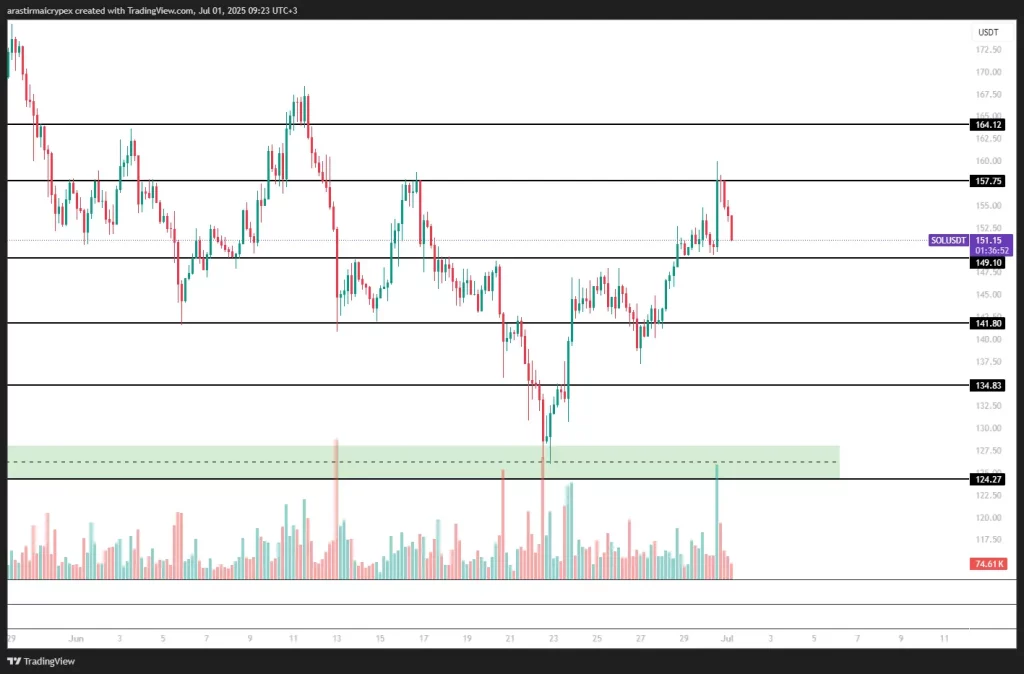First Solana ETF with Stake Rewards Coming to the US – Robinhood Expands Crypto Move with ETH-SOL Staking and Tokenized Shares
First Solana ETF with Staking Rewards Coming to the US
Rex Shares and Osprey Funds are preparing to launch the first US ETF that offers direct exposure to Solana and staking rewards. The fund, announced as the “Rex-Osprey Solana + Staking ETF,” will hold SOL assets through a subsidiary in the Cayman Islands and aim to generate returns by staking at least 50% of those assets. Unlike traditional spot ETFs, the fund will be registered under the Investment Company Act and taxed as a C-corp.
This development comes ahead of nine other spot Solana ETF applications that the SEC is currently reviewing. The Rex-Osprey ETF does not have a traditional spot ETF structure, despite tracking the spot price, and represents a first for the market in this respect. The SEC said it has “no additional comments” on the fund, indicating that there are no obstacles to approval. According to experts, there is a high probability that spot Solana ETFs will be approved and these funds are expected to enter the market in the next 2-4 months.
Robinhood Expands Crypto Move with ETH-SOL Staking and Tokenized Stocks
Robinhood took an important step in the crypto world by launching staking service for Ethereum and Solana in the US. With the staking service, users can earn rewards by contributing to network security. The company also launched many innovative products in Europe, such as 3x leveraged crypto futures, Layer-2 blockchain infrastructure and tokenized real asset transactions.
The most striking development was that Robinhood offered tokenized US stocks to its users in Europe and listed these products with zero commission and 24/5 trading opportunity. Stocks of giants such as Apple, Microsoft and Nvidia will now be traded on the blockchain. The company aims to increase this number to thousands by the end of the year and offer 24/7 trading. Robinhood also plans to offer tokenized shares of private companies that haven’t been publicly traded, such as OpenAI and SpaceX. The move would open up opportunities previously only available to wealthy investors to ordinary investors.
Circle Applies for US Bank License
Circle, the company behind USDC, has applied for a national bank license in the US. If approved, the company will be able to hold its reserves in-house and provide custody services to institutional clients. However, the license will not grant it the authority to take cash deposits or make loans like traditional banks. The new entity, which will be subject to the OCC (Office of the Comptroller of the Currency), will operate under the name “First National Digital Currency Bank, N.A.”
The move stands out as Circle’s latest move to strengthen its integration with the traditional financial system. The company was oversubscribed 25 times in its IPO on June 5, and its share price rose 167% on the first day. According to analysts, Circle’s leading stablecoin USDC is on track to become the largest regulated stablecoin under the GENIUS Act. The company’s current market value has surpassed $40 billion, while USDC’s circulating supply is at $61.5 billion.
South Korea’s Central Bank Halts CBDC Project
The South Korean Central Bank (BOK) has temporarily suspended its digital currency (CBDC) project due to the escalating stablecoin debate and cost complaints from banks. As part of the Hangang pilot project, the first phase of which has not yet been completed, 100,000 citizens had tested the CBDC in local businesses. However, the testing process was halted with a notification to the banks before the second phase could be moved on.
The decision is based on the government’s policies to support won-based stablecoins. While newly elected President Lee Jae Myung advocated allowing stablecoin issuance, tech giants such as Kakao and Naver have also started to enter the field. Eight major banks are also preparing to jointly issue a won-backed stablecoin. These developments have made the future of the CBDC project uncertain, with BOK also approaching stablecoins positively.
Probability of SOL, XRP and LTC ETF Approval Increases to 95%
Analysts have increased the probability of spot ETF approval for Solana, XRP and Litecoin to 95%. According to Bloomberg ETF experts Eric Balchunas and James Seyffart, the US Securities and Exchange Commission (SEC) is expected to approve these three altcoins by the end of the year. It is also stated that a crypto basket (index-based) ETF may be approved this week. The broad wave of crypto ETFs is expected to be launched in the second half of 2025.
The probability of spot ETF approval for other altcoins such as Dogecoin, Cardano, Polkadot, Hedera and Avalanche is estimated at 90%. For Sui and Tron, this ratio is at 60% and 50%, respectively. These developments, combined with the launch of the first US staking reward Solana ETF announced last week, have strengthened the “Altcoin ETF summer” discourse. However, the SEC has again postponed its decisions on Ethereum staking ETFs, indicating that regulatory uncertainty continues.
Strategy Buys Another 4,980 BTC
Strategy, led by Michael Saylor, spent $531.9 million to buy another 4,980 Bitcoin last week. The purchase was largely financed by the sale of common stock, with a smaller portion coming from preferred stock. The company’s total BTC holdings thus reached 597,235 coins, purchased at an average price of $70,982 at a cost of $42.4 billion.
At today’s prices (approximately $107,500), the market value of Strategy’s BTC holdings exceeds $64 billion. With this size, the company remains the largest publicly traded institution holding Bitcoin. Strategy’s shares, which continue its BTC purchase strategy, also rose 1.3% in pre-market trading.
Kazakhstan Establishes National Reserve with Confiscated and State-Produced Crypto Assets
The Central Bank of Kazakhstan plans to establish a centrally managed crypto asset reserve using confiscated and state-produced crypto assets. The bill, prepared in line with the proposal from members of parliament, aims to manage sovereign crypto reserves in accordance with international standards based on the principles of transparency and sustainability. Bank President Timur Suleimenov emphasized that it is imperative that the reserve be managed institutionally and centrally due to high volatility and security risks.
In line with this plan, a new regulation is being prepared that legally defines digital assets. In addition, the Central Bank plans to launch a “Digital Asset Regulation Sandbox” where fintech and crypto companies can test new technologies under regulatory supervision. Crypto trading is currently only allowed in the country through licensed platforms at the Astana International Financial Center. Major exchanges such as Binance and Bybit also operate within this legal framework.
Sparkassen to Offer Crypto Trading to 50 Million Customers by 2026
Germany’s largest banking group, Sparkassen-Finanzgruppe, plans to offer its individual customers the opportunity to trade leading crypto assets such as Bitcoin and Ethereum directly from their accounts by summer 2026. The move comes as Sparkassen reverses its previously cautious stance on crypto assets following the regulatory clarity brought by the European Union’s MiCA regulations. The service will be developed and managed by its wholly-owned subsidiary Dekabank.
Dekabank had previously secured a crypto custody license from BaFin to offer services to institutional clients. The retail expansion is seen as the next strategic step. Sparkassen’s move aims to meet the growing demand for regulated crypto products in Europe from individual investors. Sparkassen’s customer base of close to 50 million could significantly accelerate Germany’s mainstream adoption of the digital asset market.
Bhutan Transfers $15 Million in BTC
The Royal Government of Bhutan transferred 137,245 BTC, worth approximately $14.77 million, to a crypto trading platform on June 30. This on-chain movement came at a time when the country’s total Bitcoin holdings reached 11,924 BTC (about $1.28 billion). The transfer is said to have increased speculation that some of the BTC accumulated through state-backed mining activities could be offered for sale.
Wallet movements have drawn the attention of investors as Bhutan plans to increase its mining capacity to 600 megawatts by 2025 in collaboration with Bitdeer. Bitcoin’s failure to reach new highs despite institutional purchases has led to comments that profit-taking by such large investors is putting pressure on the price. Although the Bhutanese Government has not yet made an official statement, this transfer to the platform has increased the expectation of sales in the market.
——————————————————————————————
BITCOIN (BTC)
BTC is trading at $ 106,905 as of the morning hours, losing 0.26%. The price retreated due to selling pressure from the $ 107,827 resistance and is currently testing the support zone in the $ 105,984 – $ 106,000 band.
As long as this support is maintained, upward attempts may be on the agenda again. While $ 107,827 is watched as the first resistance above, $ 108,875 may be the next target if this level is exceeded. In a possible downward break, $ 103,502 levels can be followed as support below $ 105,984.
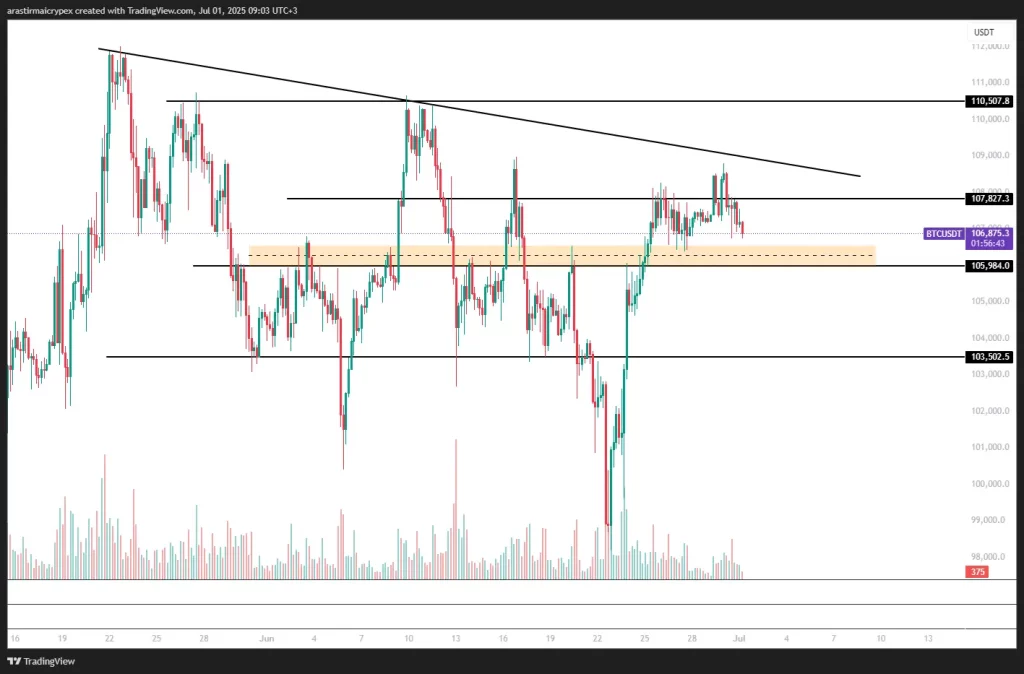
ETHEREUM(ETH)
ETH is priced at $ 2,458 as of the morning hours with a 1.08% gain in value.
The price gave a positive signal by moving upwards from the $ 2,466 – $ 2,392 band, where a horizontal movement has been observed for a long time. However, it could not maintain its permanence above it. If the pullback continues, 2,392 is the next important support position. If it drops below this area, the $ 2,285 level may come to the agenda again. In case of a possible positive trend, it will be important for it to rise above $ 2,466 again. Then, the 2,522 and 2,590 levels can be targeted.
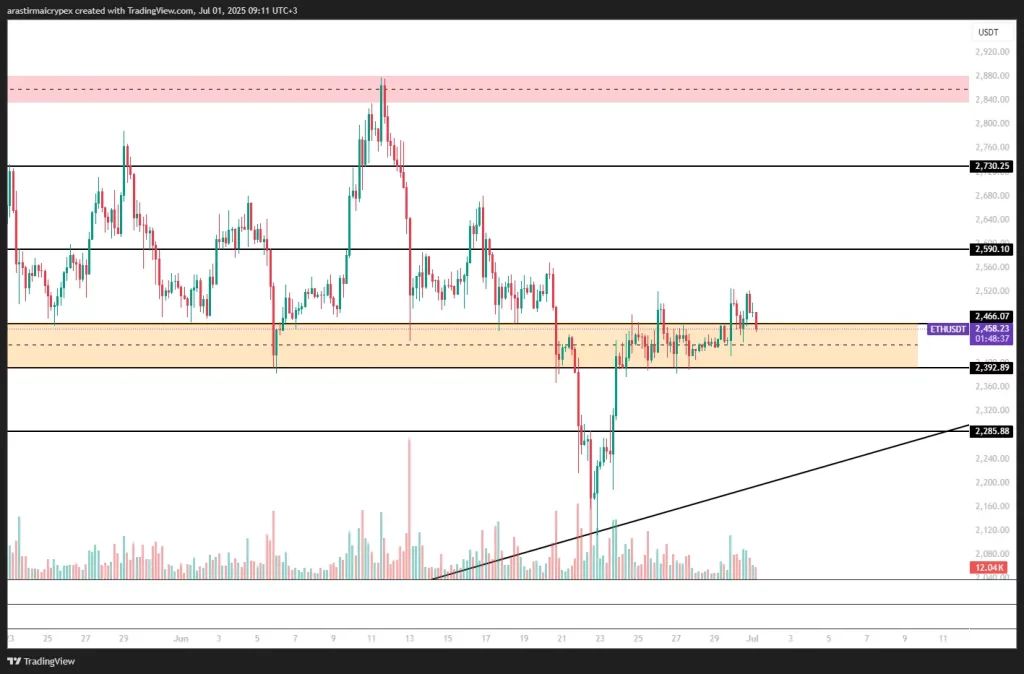
RIPPLE(XRP)
XRP is priced at $ 2.21 as of the morning hours with a 1.15% loss in value. The price, which was rejected from the 2.2737 resistance after yesterday’s sharp rise, is currently testing the short-term support level of 2.2122. If this level is maintained, an attack towards the 2.2737 resistance may be seen again. Otherwise, in the continuation of the downward movement, the $ 2.1304 and $ 2.0865 levels will be followed as support, respectively. In particular, the green zone around 2.0865 continues to be an important demand area where buyers are concentrated. The reaction of the price at the support levels will be decisive in terms of the short-term direction.
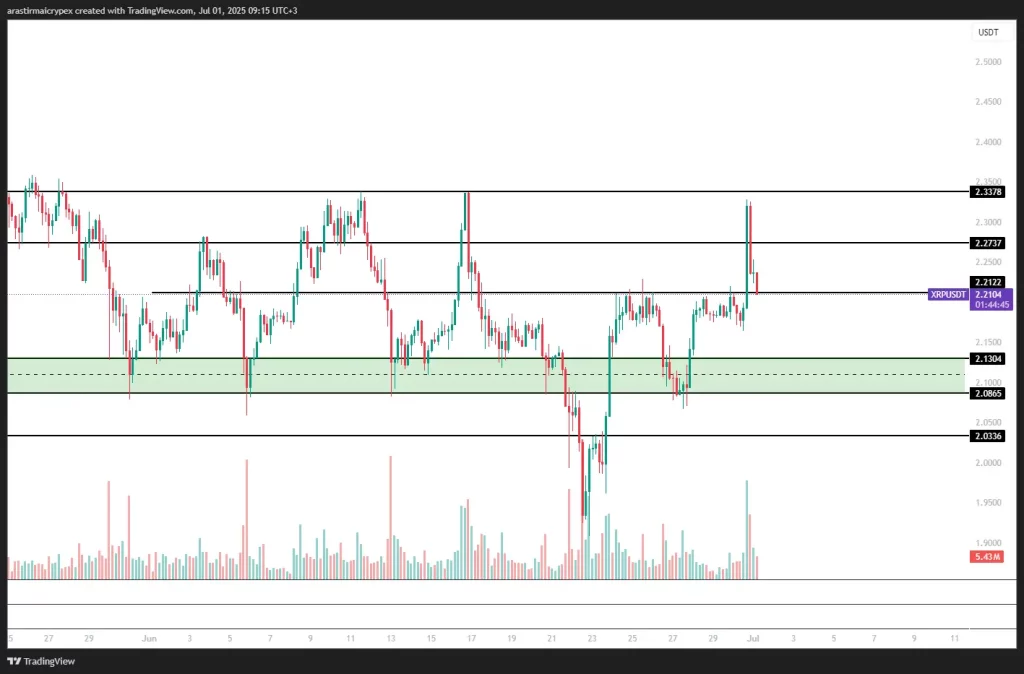
AVALANCHE(AVAX)
AVAX is trading at $17.50 levels with a 2.45% loss in value as of the morning hours. AVAX, which failed to overcome the 18.69 resistance, is retreating with the selling pressure from this level. It is currently priced in the intermediate support area at 17.61. If this level is maintained, the price is likely to retreat towards the green demand zone between $ 16.44 – $ 15.60.
In upward movements, the first strong resistance is at $ 18.69. If this level is exceeded, the $ 19.86 and $ 21.52 resistances may come to the fore again.
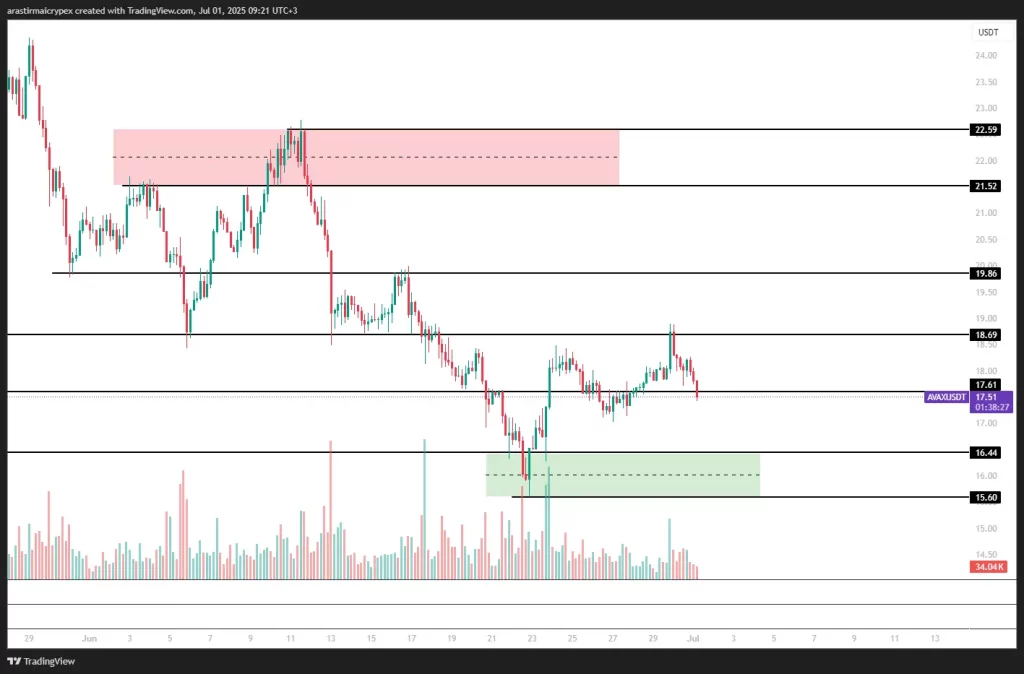
SOLANA(SOL)
SOL is traded at $151 levels with a 2.40% loss in value as of the morning hours. The price, which rose to the 157.75 resistance yesterday, retreated with the sales from this region and is approaching the 149.10 support level.
In the short term, the 149.10 level stands out as an important intermediate support. If it remains below this level, the next support points can be followed as 141.80 and 134.83. In a stronger downside scenario, the price may be expected to head towards the green demand zone in the $124.27 – $127 band. In upward attacks, the first resistance is the 157.75 level. If this resistance is overcome, the 164.12 level can be followed as the next target.
